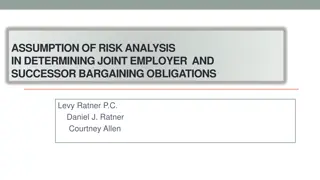Understanding Collective Bargaining: Insights on Wage Setting in Africa
Explore wage-setting systems in Africa through collective bargaining negotiations to address inequality and social justice. This paper analyzes the content of agreements using the WageIndicator database, shedding light on pay-settings and related clauses. Specific issues addressed include additional
0 views • 10 slides
Achieving Environmental Sustainability in Australian Universities: NTEU's Campaign and Successes
NTEU's campaign for environmental sustainability in Australian universities has led to significant achievements, with 26 out of 38 universities making sustainability claims. The successful integration of sustainability clauses in bargaining agreements reflects the commitment to environmentally susta
5 views • 17 slides
Understanding Plea Bargaining in Criminal Procedure Code, 1973
Plea bargaining, a pre-trial negotiation process where the accused pleads guilty for certain concessions, has a historical background and aims to reduce trial delays and ensure just punishment. Introduced in 2005, Chapter 21A of the Cr.P.C. outlines the concept. It applies to offenses with punishmen
2 views • 21 slides
Maryland Community College Collective Bargaining: Overview & Implementation
Maryland's Community College Collective Bargaining Law, enacted in 2021, grants employees bargaining rights. The law covers union representation selection, bargaining obligations, unfair labor practice protection, and enforcement by the State Higher Education Labor Relations Board (SHELRB). SHELRB o
1 views • 33 slides
Overview of Collective Bargaining in the Department of Employment and Labour
The Department of Employment and Labour Portfolio Committee Workshop in February 2021 discussed collective bargaining, emphasizing the protection of trade unions and employers' organizations in engaging in negotiations. Levels of bargaining include centralized, company level, and plant level negotia
0 views • 17 slides
A Guide to Collective Bargaining in Illinois: Understanding the Public Labor Relations Act
Dive into the essential aspects of collective bargaining within the framework of the Illinois Public Labor Relations Act. Learn about laws, coverage, and exclusions, including key provisions for public employers, employees, and labor organizations involved in negotiations.
0 views • 74 slides
Understanding Plea Bargaining: Definition, Applicability, and Process
Plea bargaining is a negotiation process between the prosecution and defense, allowing the accused to plead guilty for reduced punishment. It aims to expedite case disposal and lessen court burden. Applicability criteria include offenses with a maximum 7-year sentence, involving women or children un
0 views • 14 slides
Overview of Cooperative Game Theory and Bargaining Solutions
Cooperative game theory explores situations where players have mutual benefits in cooperating. The focus is on bargaining solutions to reach agreements despite conflicting interests. Key concepts include Nash Bargaining Solution, Kalai-Smorodinsky Bargaining Solution, and Rubinstein Bargaining Proce
1 views • 24 slides
Impact of Alternatives to Prosecution on International Co-operation: Indian Perspective
The Indian perspective on the impact of alternatives to prosecution, such as plea bargaining, compounding of offences, probation, arbitration, compensation, open prisons, and immunity from prosecution for volunteering narcotic addicts, reflects a historical evolution in the legal system. The concept
1 views • 13 slides
Public Service Employment Relations in South Africa: Overview
The South African public service employment relations are governed by various acts including the Labour Relations Act, Basic Conditions of Employment Act, and others. The legal framework emphasizes collective bargaining, with the Public Service Coordinating Bargaining Council playing a key role. The
0 views • 17 slides
Understanding Labour Relations in Entrepreneurship
This module delves into the intricacies of labour relations within entrepreneurship. Topics covered include collective bargaining, mediation, arbitration, and applicable labour legislation for small businesses. The importance of good labour relations and disciplinary actions for code violations are
0 views • 18 slides
Understanding the Coase Theorem: Property Rights and Economic Efficiency
The Coase Theorem, developed by economist Ronald Coase, posits that under certain conditions, bargaining related to property rights will lead to an optimal outcome regardless of the initial distribution. It provides a framework for resolving conflicts by emphasizing negotiation and efficient market
0 views • 10 slides
Understanding Price Elasticity in Economics
Explore the key concepts of price elasticity in economics, including calculations, determinants, and applications. Understand the differences between price elasticity of demand and supply, learn how to calculate price elasticity, and interpret elasticity coefficients. Discover the responsiveness of
1 views • 31 slides
Understanding Plea Bargaining in Criminal Cases
Plea bargaining is a negotiation process where the accused admits guilt in exchange for a reduced punishment. It helps in resolving cases faster and reducing court congestion. The concept is applicable to cases with a maximum sentence of 7 years, not involving women or children under 14, and not imp
2 views • 14 slides
Understanding Price Indices in Economics
Exploring the concept of price indices in economics, focusing on composite price indexes, weighted and unweighted indices, and their importance in measuring relative prices. A practical illustration using the example of tea consumption showcases how price indices help in understanding cost changes o
0 views • 31 slides
Price-Output Determination Under Low-Cost Price Leadership
Economists have developed models on price-output determination under price leadership, with assumptions about leader and follower behavior. In this scenario, two firms, A and B, with equal market share and homogeneous products, navigate pricing strategies based on cost differentials. Firm A, with lo
1 views • 7 slides
Application of Price Adjustment in Civil Works Contracts: Lessons from Nigeria
The construction industry faces challenges due to price fluctuations in construction materials, especially in countries with unstable currencies. Civil works contracts funded by the World Bank are eligible for price adjustments if the contract duration exceeds 18 months. This presentation highlights
0 views • 21 slides
Understanding Collective Bargaining in the Department of Employment and Labour Portfolio Committee Workshop
The Department of Employment and Labour Portfolio Committee Workshop in February 2021 focused on the importance of collective bargaining in South Africa. The workshop highlighted the protection of the right to engage in collective bargaining as outlined in the country's Constitution and the signific
0 views • 17 slides
Understanding Weighted Price Indices in Economics
Weighted price indices are essential in economics to measure changes in prices over time. Different methods such as Laspeyre's and Paasche's price indices offer ways to calculate these indices using weighted averages. Fisher's index combines both methods to provide a comprehensive view. The weighted
3 views • 9 slides
Price Index Session VII - Designing Price Data Collection System
This session delves into the process of designing a price data collection system, focusing on product specification, setting norms for item substitution, outlet selection, determining frequency and timing, method of data collection, treatment of seasonal products, quality adjustment, and dealing wit
0 views • 47 slides
Understanding Price Determination in Livestock Economics and Marketing
Price determination under perfect competition involves the interaction of demand and supply curves to reach equilibrium, where the quantity demanded and supplied are balanced at an equilibrium price. In perfect competition, price is determined at the point where demand and supply intersect. Demand v
0 views • 16 slides
Challenges in Promoting Collective Bargaining and Fighting Anti-Union Busting
The European Trade Union Confederation (ETUC) highlights the importance of the Directive on adequate minimum wages in the EU to combat union busting practices. While the Directive addresses some demands related to promoting collective bargaining, there is a need for further strengthening to effectiv
0 views • 13 slides
Understanding Price Index: Issues and Concepts
Price indices play a crucial role in measuring changes in prices of goods and services. This presentation covers the construction of price indices, defining purposes, selecting base periods, assigning weights, and more. Explore the purpose, scope, and coverage of price indices as measures of inflati
0 views • 32 slides
Understanding Collective Bargaining in School Districts
Collective bargaining in school districts involves negotiating over mandatory and permissive subjects such as wages, hours, and conditions of employment. School districts must differentiate between mandatory and permissive subjects, and disputes over mandatory subjects must be resolved through impas
0 views • 29 slides
Comparison of APSCUF CBA with Other Contracts in Higher Education
Explore the key provisions of the APSCUF Collective Bargaining Agreement (CBA) that aims to protect and defend faculty members in higher education. Compare how the APSCUF CBA differs from other contracts in areas such as coverage of adjuncts, conversion language, pay scales, and more. Delve into art
0 views • 44 slides
Comparative Analysis of Plea Bargaining in Criminal Justice Systems
Research by Dr. Dorota Czerwinska delves into the practice of plea bargaining, examining its roots, benefits, and ethical considerations in various countries such as the USA, England, France, Germany, Italy, and Poland. The study explores the reasons behind the development of plea bargaining and que
0 views • 27 slides
Constructing Price Index: General Procedure and Aggregation
The process of constructing a price index involves various steps such as computation of price relatives, aggregation at different levels, selection of base period, and designing data collection methods. Weighted arithmetic mean and simple ratio calculations are used in aggregating price indices. A t
0 views • 31 slides
Understanding Price Elasticity of Demand in Economics
Price elasticity of demand is a crucial concept in economics that measures how much the quantity demanded of a good changes in response to a change in its price. Factors influencing own-price elasticity, cross-price elasticity, income elasticity, and supply elasticity are explained and illustrated u
0 views • 19 slides
Understanding Elasticity in Economics
Elasticity in economics refers to the responsiveness of demand to price changes. A more elastic curve results in larger quantity changes for small price changes, while a less elastic curve requires larger price changes to affect quantity consumed. The elasticity of demand can be measured by calculat
1 views • 13 slides
Understanding Price Elasticity of Supply in Economics
Price elasticity of supply measures how much the quantity supplied responds to changes in price. It can be inelastic (quantity supplied responds slightly), elastic (quantity supplied responds substantially), or unit-elastic (price elasticity of supply equals 1). Various determinants like the passage
0 views • 16 slides
Understanding Degrees of Elasticity of Demand
Elasticity of demand refers to the responsiveness of quantity demanded to changes in price. Perfectly elastic demand occurs when there is an infinite demand at a particular price and demand becomes zero with a slight rise in price. Conversely, perfectly inelastic demand occurs when there is no chang
0 views • 11 slides
Gender Equity and Collective Bargaining for Women Workers
Gender equity and collective bargaining play crucial roles in addressing gender inequality in the workplace. By advocating for fair treatment and opportunities for women, addressing discrimination, and organizing around women workers' rights, these efforts can combat the systemic issues that contrib
0 views • 17 slides
Addressing Income Inequality Through Broader-Based Bargaining
A discussion on broader-based bargaining as a solution to income inequality in Ontario, despite the challenges faced in implementing it. The review highlights the importance of addressing inequality in the workforce and explores the impact of broader-based bargaining on wages, union coverage, and ov
0 views • 20 slides
Health Care Bargaining Strategies Without Violating P.E.R.A.
Strategies for addressing health care in collective bargaining without violating P.E.R.A., including insights on mandatory bargaining subjects, likely litigation issues, and challenges faced. Exploring general rules, problematic aspects, potential ULPs, and premature impasse declarations in health c
0 views • 29 slides
Evolution of Collective Bargaining in Louisiana's School Systems
The Federation in Louisiana was chartered in 1979, eventually securing collective bargaining rights in 1991 after multiple cycles of school board elections. Currently, it is the only school system in the state with wall-to-wall collective bargaining. The Federation has established specific provision
0 views • 26 slides
Changes to Price Adjustment Provisions in Construction Management
The content discusses changes in price adjustment provisions for asphalt binder indices, bid indices, and bituminous price adjustment. It covers the removal of standard specifications, the use of specific binder types, and the application of price adjustments on a contract basis. The focus is on usi
0 views • 27 slides
The German Experience with Social Dialogue and Collective Bargaining in Journalism
Germany has a unique history with social dialogue and collective bargaining in journalism, with differing opinions on its applicability in the industry. Collective bargaining for journalists began in the 1950s, but the implementation has varied across different media sectors. While public broadcasti
0 views • 9 slides
Evolution and Significance of Collective Bargaining in Industrial Relations
The term "collective bargaining" was coined in 1891 by Mrs. Beatrice Webb to represent workers' efforts to secure better wages and benefits collectively. The concept gained legal recognition in 1956 to formalize agreements between employers and workers. Collective bargaining resolves disputes and ev
0 views • 6 slides
Analysis of Joint Employer and Successor Bargaining Obligations
Delve into the complexities of joint employer relationships and successor bargaining obligations through the lens of assumption of risk analysis. Explore key cases, such as Browning Ferris Industries and Nexeo Solutions, to understand the evolving legal landscape surrounding collective bargaining ri
0 views • 21 slides
Understanding Price Discrimination in Monopoly Markets
Price discrimination under monopoly occurs when businesses charge different prices to different consumer groups for the same product or service. Conditions for price discrimination include monopoly power, market segmentation, ability to separate consumer groups, and prevention of resale. Examples of
0 views • 12 slides







































